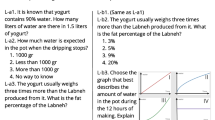Abstract
This article discusses the role of context problems, as they are used in the Dutch approach that is known as realistic mathematics education (RME). In RME, context problems are intended for supporting a reinvention process that enables students to come to grips with formal mathematics. This approach is primarily described from an instructional-design perspective. The instructional designer tries to construe a route by which the conventional mathematics can be reinvented. Such a reinvention route will be paved with context problems that offer the students opportunities for progressive mathematizing. Context problems are defined as problems of which the problem situation is experientially real to the student. An RME design for a calculus course is taken as an example, to illustrate that the theory based on the design heuristic using context problems and modeling, which was developed for primary school mathematics, also fits an advanced topic such as calculus. Special attention is given to the RME heuristic that refer to the role models can play in a shift from a model of situated activity to a model for mathematical reasoning. In light of this model-of/model-for shift, it is argued that discrete functions and their graphs play a key role as an intermediary between the context problems that have to be solved and the formal calculus that is developed.
Similar content being viewed by others
References
Bishop, A.J., Clements, K., Keitel, Ch., Kilpatrick, J. and Laborde, C. (eds.): 1996, International Handbook on Mathematics Education, Kluwer Academic Publishers, Dordrecht.
Clagett, M.: 1959, Science of Mechanics in the Middle Ages, The University of Wisconsin Press, Madison.
Dijksterhuis, E.J.: 1980, De Mechanisering van het Wereldbeeld, Meulenhoff, Amsterdam.
DiSessa, A.A., Hammer, D., Sherin, B. and Kolpakowski, T.: 1991, 'Inventing graphing: meta-representational expertise in children', Journal of Mathematical Behavior 10, 117–160.
Freudenthal, H.: 1971, 'Geometry between the devil and the deep sea', Educational Studies in Mathematics 3, 413–435.
Freudenthal, H.: 1973, Mathematics as an Educational Task, D. Reidel, Dordrecht.
Freudenthal, H.: 1991, Revisiting Mathematics Education, Kluwer Academic Publishers, Dordrecht.
Gravemeijer, K.: 1994, 'Educational development and educational research in mathematics education', Journal for Research in Mathematics Education 25(5), 443–471.
Gravemeijer, K.: 1999, 'How emergent models may foster the constitution of formal mathematics', Mathematical Thinking and Learning 1(2), 155–177.
Gravemeijer, K., Cobb, P., Bowers, J. and Whitenack, J.: in press, 'Symbolizing, modeling, and instructional design', in P. Cobb, E. Yackel and K. McClain (eds.), Communicating and Symbolizing in Mathematics: Perspectives on Discourse, Tools, and Instructional Design, Lawrence Erlbaum Associates, Mahwah, NJ.
Greeno, J.G.: 1991, 'Number sense as situated knowing in a conceptual domain', Journal for Research in Mathematics Education 22, 170–218.
Kaput. J.J.: 1994a, 'The representational roles of technology in connecting mathematics with authentic experience', in R. Biehler, R.W. Scholz, R. Sträßer, B. Winkelmann (eds.), Didactics of Mathematics as a Scientific Discipline, Kluwer Academic Publishers, Dordrecht, pp. 379–397.
Kaput, J.J.: 1994b, 'Democratizing access to calculus: new routes to old roots', in A.H. Schoenfeld (ed.), Mathematical Thinking and Problem Solving, Lawrence Erlbaum Associates, Publishers, Hove, UK.
Kindt, M.: 1996, Som & verschil, afstand & snelheid. Differentiaal-en Integraalrekening deel 1, Freudenthal Institute, Utrecht.
Lehrer, R. and Romberg, T.: 1996, 'Exploring children's data modeling', Cognition and Instruction 14, 69–108.
Lindberg, D.C.: 1992, The Beginnings of Western Science, The University of Chicago Press, Chicago.
Meira, L.: 1995, 'The microevolution of mathematical representations in children's activity', Cognition and Instruction 13(2), 269–313.
Nemirovsky, R.: 1994, 'On ways of symbolizing: The case of laura and velocity sign', Journal of Mathematical Behavior 13, 389–422.
Nemirovsky: 1995, Personal communication.
Polya, G.: 1963, Studies in Mathematics, Volume XI, Mathematical Methods in Science, School Mathematics Group, Stanford.
Sfard, A.: 1991, 'On the dual nature of mathematical conceptions: Reflections on processes and objects as different sides of the same coin', Educational Studies in Mathematics 22, 1–36.
Streefland, L.: 1985, 'Wiskunde als activiteit en de realiteit als bron', Nieuwe Wiskrant, 5,1, 60–67.
Streefland, L.: 1990, Fractions in Realistic Mathematics Education, a Paradigm of Developmental Research, Kluwer Academic Publishers, Dordrecht.
Stephan, M.: 1998, Supporting the Development of One First-grade Classroom's Conceptions of Measurement: Analyzing Students' Learning in Social Context, Unpublished Doctoral Dissertation, Vanderbilt University, Nashville, TN.
Tall, D.O.: 1985, 'The gradient of a graph', Mathematics Teaching 111, 48–52.
Tall, D.O.: 1986, 'A graphical approach to integration', Mathematics Teaching 114, 48–51.
Tall, D. (Ed.): 1991, Advanced Mathematical Thinking, Kluwer Academic Publishers, Dordrecht.
Treffers, A.: 1987, Three Dimensions. A Model of Goal and Theory Description in Mathematics Education: The Wiskobas Project, D. Reidel, Dordrecht.
Treffers, A.: 1991, 'Didactical background of a mathematics program for primary education', in L. Streefland (ed.), Realistic Mathematics Education in Primary School, CD-ß Press, Utrecht, pp. 21–57.
Whitney, H.: 1988, 'Mathematical reasoning, early grades', Princeton (unpublished paper).
Yackel, E. and Cobb, P.: 1996, 'Sociomath norms, argumentation, and autonomy in mathematics', Journal for Research in Mathematics Education 27.
Author information
Authors and Affiliations
Rights and permissions
About this article
Cite this article
Gravemeijer, K., Doorman, M. Context Problems in Realistic Mathematics Education: A Calculus Course as an Example. Educational Studies in Mathematics 39, 111–129 (1999). https://doi.org/10.1023/A:1003749919816
Issue Date:
DOI: https://doi.org/10.1023/A:1003749919816




